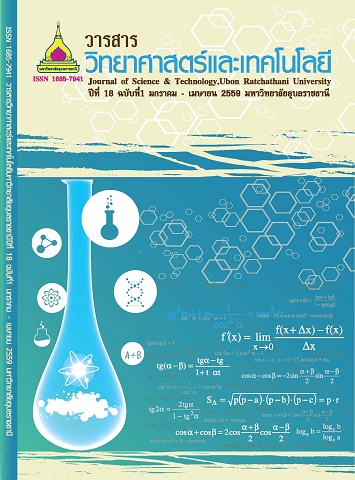การใช้น้ำมันหอมระเหยจากสมุนไพรไทยในการยับยั้งการเจริญของเชื้อราที่พบ บนแผ่นยางพารา
Main Article Content
บทคัดย่อ
งานวิจัยนี้มีวัตถุประสงค์ศึกษาประสิทธิภาพของน้ำมันหอมระเหยจาก กานพลู อบเชย ตะไคร้หอม ใบพลู ใบแก้ว ใบยูคาลิปตัส ผิวมะกรูด และใบมะกรูดที่สกัดโดยการต้มกลั่น ในการยับยั้งเชื้อรา Penicillium sp. (NY1 รหัส 40), Aspergillus sp. (T2 รหัส 23), Aspergillus sp. (K2 รหัส 27), และ T3 รหัส 23 ซึ่งเป็นเชื้อราที่แยกได้จากยางแผ่นดิบ การยับยั้งเชื้อราทดสอบด้วยวิธี paper disc diffusion พบว่าอบเชยมีประสิทธิภาพในการยับยั้งเชื้อราทั้ง 4 ชนิดได้ดีที่สุด ความเข้มข้นที่สามารถยับยั้งเชื้อราได้ของน้ามันหอมระเหยอบเชยกับเชื้อรา Penicillium sp. (NY1 รหัส 40), Aspergillus sp. (T2 รหัส 23) Aspergillus sp. (K2 รหัส 27) และ T3 รหัส 23 คือ 25,000 ppm สำหรับน้ำมันหอมระเหยจากกานพลู ผิวมะกรูด ตะไคร้หอม มีค่าความเข้มข้นที่สามารถยับยั้งเชื้อราได้เท่ากับ 100,000 ppm ประสิทธิภาพการยับยั้งเชื้อราบนยางแผ่นทำได้โดยการสเปรย์น้ำมันหอมระเหยที่มีความเข้มข้นที่สามารถยับยั้งเชื้อราได้ลงบนยางแผ่นแล้วหยดเชื้อราบนยางแผ่น สังเกตการเกิดเชื้อรา สำหรับชุดควบคุมคือแผ่นยางที่ไม่ได้สเปรย์ด้วยน้ำมันหอมระเหยพบว่ามีเชื้อราขึ้นหลังบ่มเพาะ 1 วัน ส่วนยางแผ่นที่สเปรย์ด้วยน้ำมันหอมระเหยจาก อบเชย ผิวมะกรูด กานพลู ตะไคร้หอมสามารถยับยั้งเชื้อรา Aspergillus sp. (T2 รหัส 23) ได้มากกว่าชุดควบคุมเป็นเวลา 28, 28, 3 และ 1 วัน ตามลำดับ สำหรับยางแผ่นที่สเปรย์ด้วยน้ำมันหอมระเหย อบเชย กานพลู ผิวมะกรูด ตะไคร้หอม สามารถยับยั้งเชื้อรา T3 รหัส 23 ได้มากกว่าชุดควบคุมเป็นระยะเวลาที่เท่ากัน คือ 28 วัน
Utilization of Essential Oils from Thai Herbs on the Inhibition of Growth of Fungi on Para Rubber Sheets
This research studied the efficiencies of essential oils from cloves, cinnamon, citronella, betel leaves, orange jasmine leaves, eucalyptus leaves, kaffir lime peel, and kaffir lime leaves by hydro-distillation on the antifungal of Penicillium sp. (NY1 code 40), Aspergillus sp. (T2 code 23), Aspergillus sp. (K2 code 27), and T3 code 23. The antifungal activity was tested by paper disc diffusion. The essential oils were sprayed on rubber sheets, fungi were added, and the fungi growths were observed. A control was set up that involved a rubber sheet that was not sprayed with essential oil and fungi were added and observed. Cinnamon was the most effective essential oil on the inhibition of growth at 25,000 ppm for Penicillium sp., Aspergillus sp., Aspergillus sp., and T3 code 23. The concentrations of essential oils from cloves, citronella, and kaffir lime leaves were 100,000 ppm for the inhibition of the growth of fungi. The rubber sprayed with essential oils from cinnamon, kaffir lime peel, cloves, and citronella against the growth of fungi Aspergillus sp. (T2 code 23) inhibited the growth of fungi more than the control for 28 days, 28 days, 3 days, and 1 day respectively. The efficiencies of essential oils from cinnamon, clove, kaffir lime peel, and citronella against the growth of fungi (T3 code 23) on the rubber sheets were all the same at 28 days more than the control.
Article Details
บทความที่ได้รับการตีพิมพ์เป็นลิขสิทธิ์ของ วารสารวิทยาศาสตร์และเทคโนโลยี มหาวิทยาลัยอุบลราชธานี
ข้อความที่ปรากฏในบทความแต่ละเรื่องในวารสารวิชาการเล่มนี้เป็นความคิดเห็นส่วนตัวของผู้เขียนแต่ละท่านไม่เกี่ยวข้องกับมหาวิทยาลัยอุบลราชธานี และคณาจารย์ท่านอื่นๆในมหาวิทยาลัยฯ แต่อย่างใด ความรับผิดชอบองค์ประกอบทั้งหมดของบทความแต่ละเรื่องเป็นของผู้เขียนแต่ละท่าน หากมีความผิดพลาดใดๆ ผู้เขียนแต่ละท่านจะรับผิดชอบบทความของตนเองแต่ผู้เดียว


